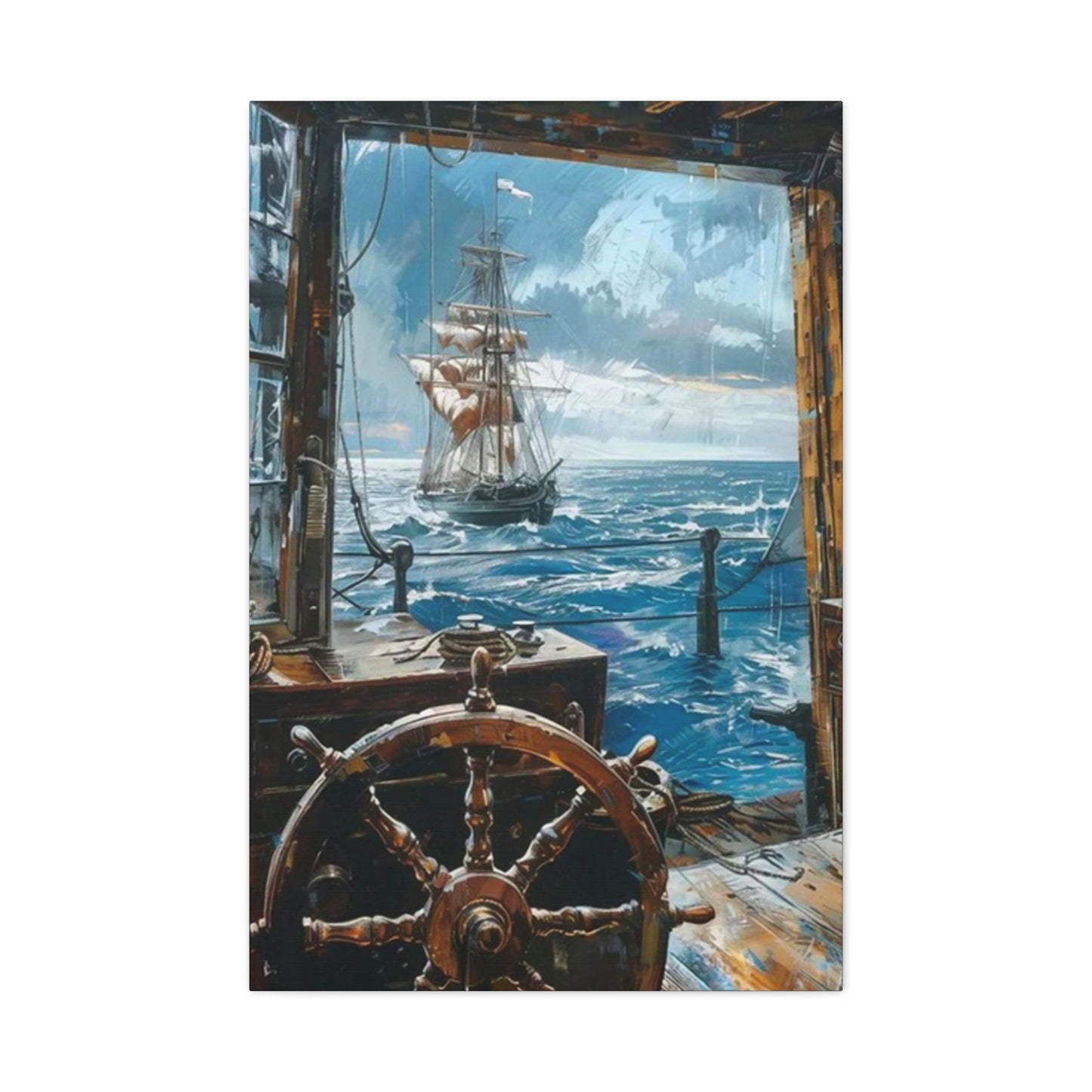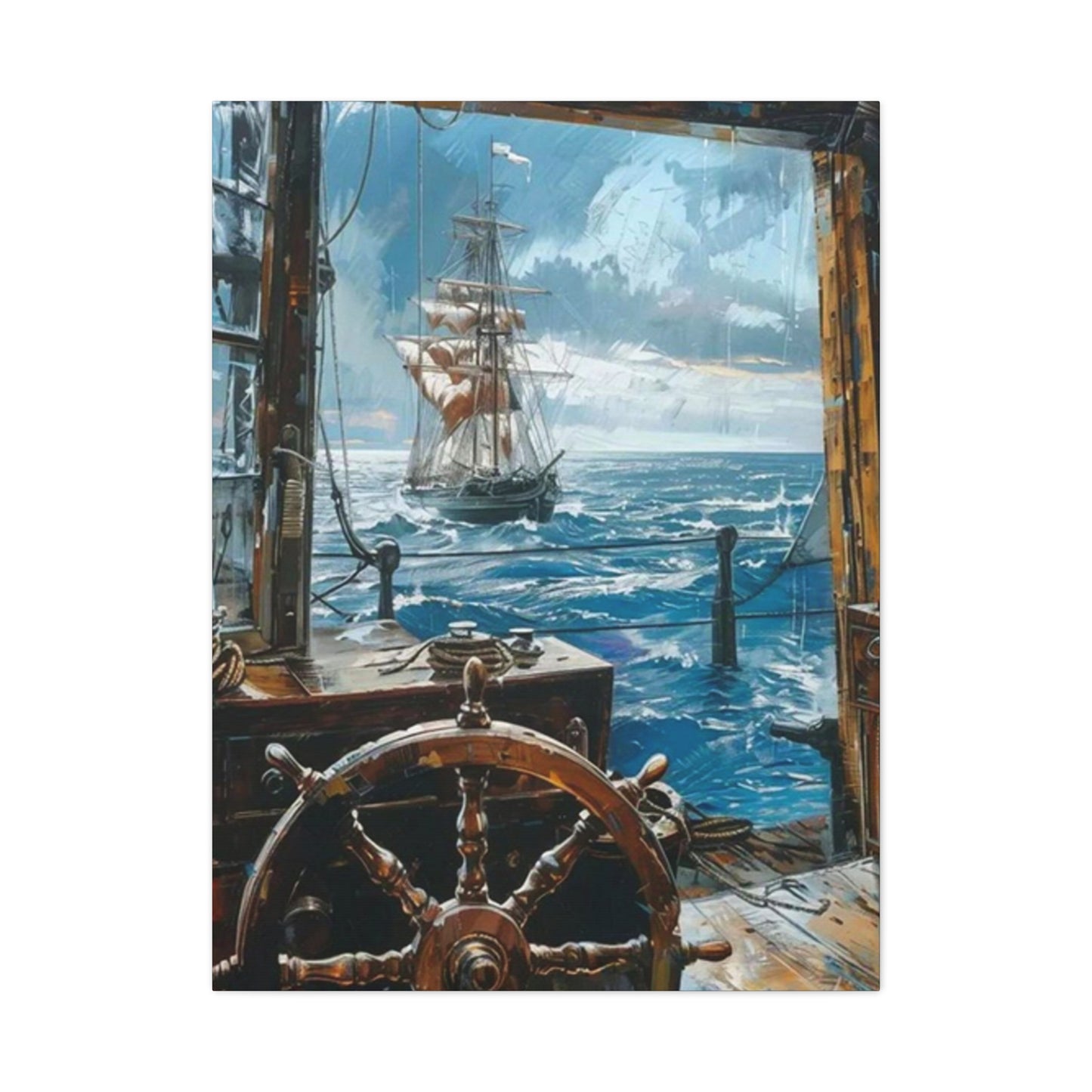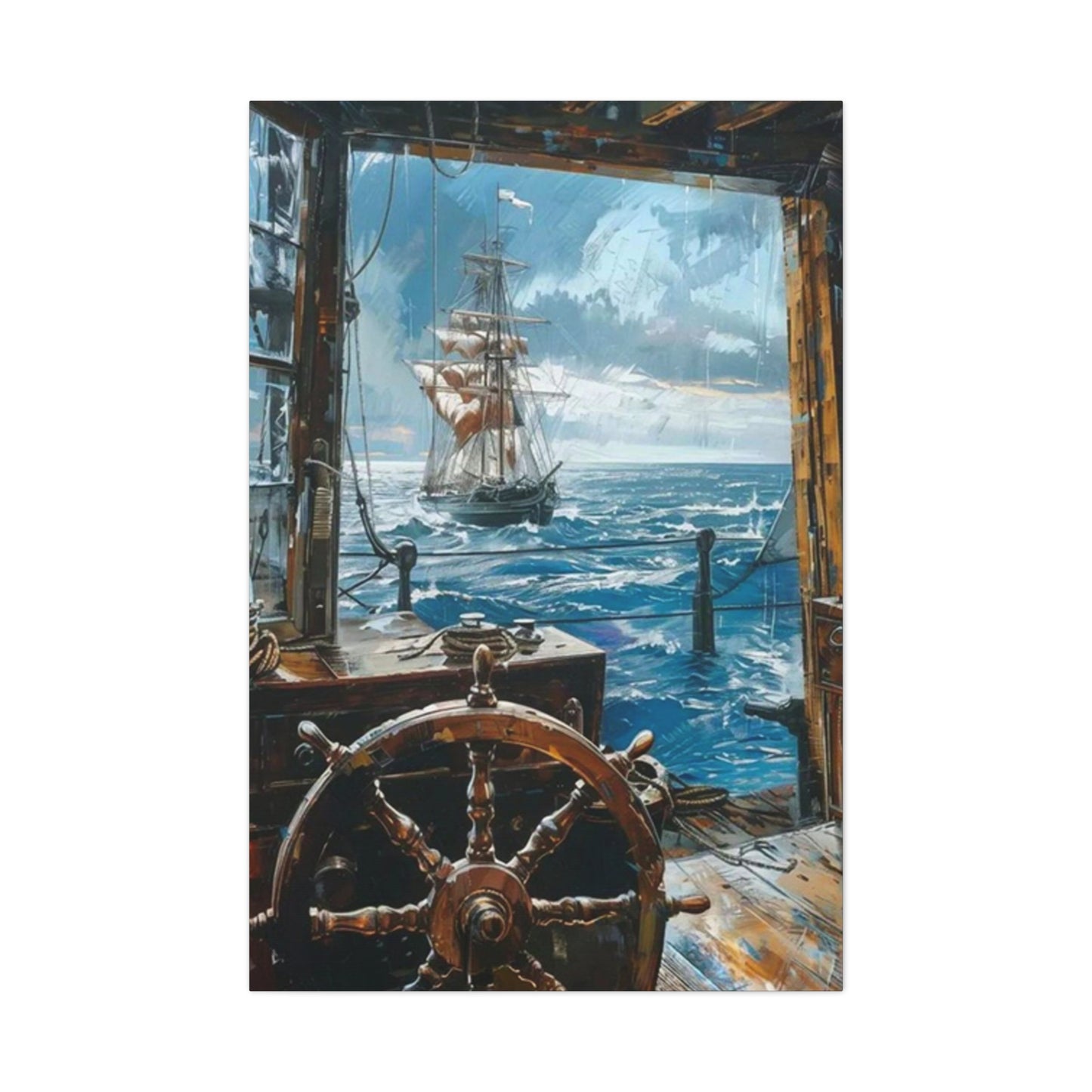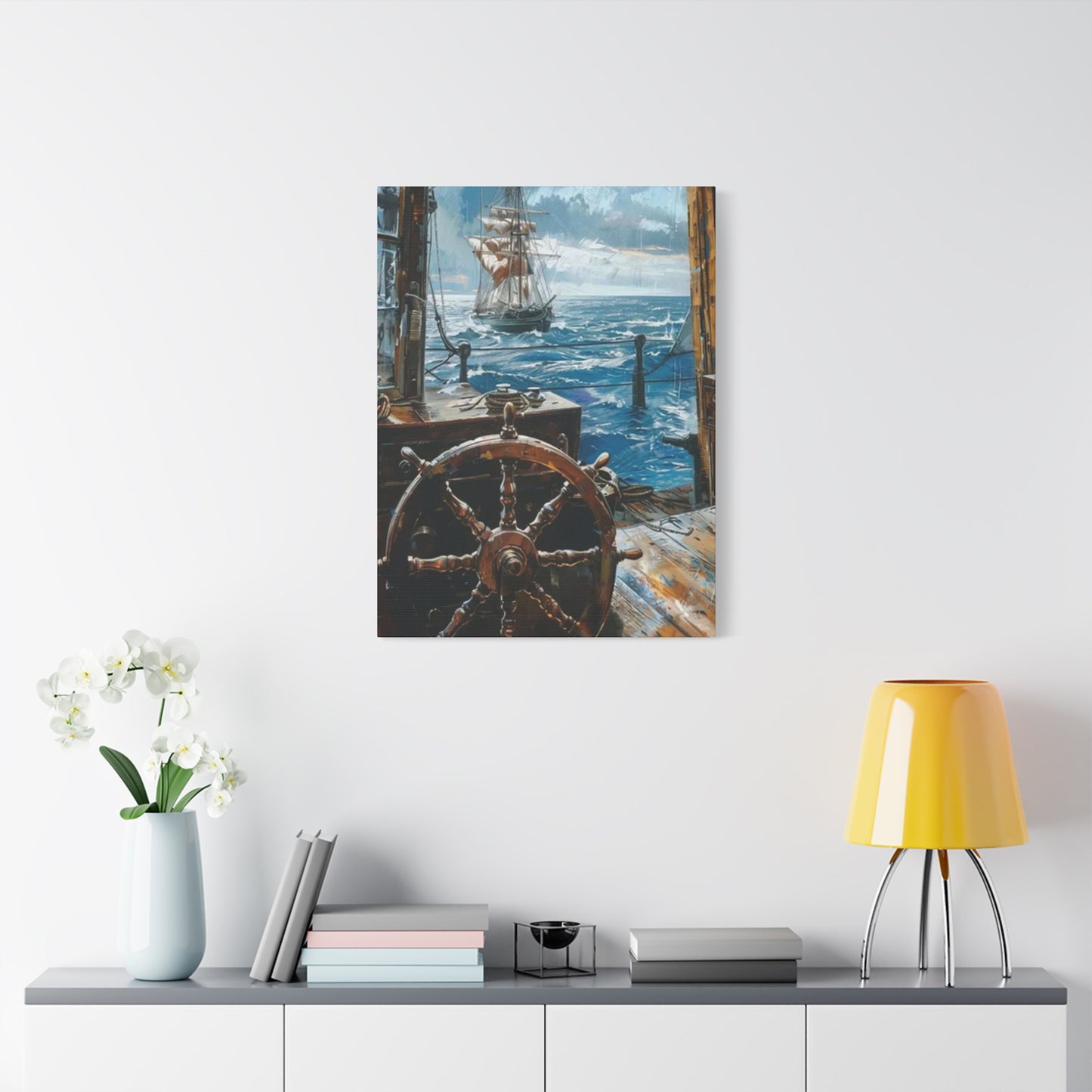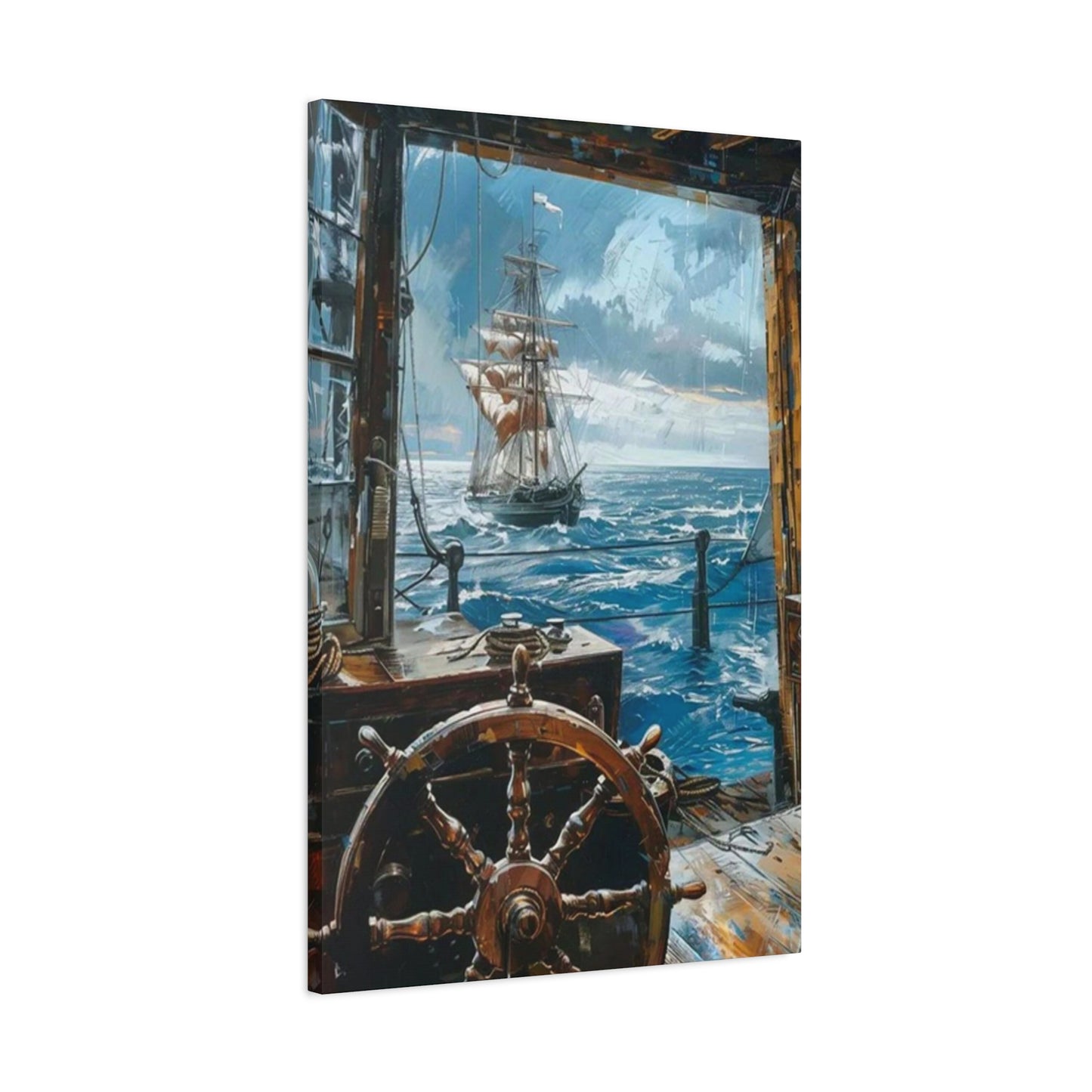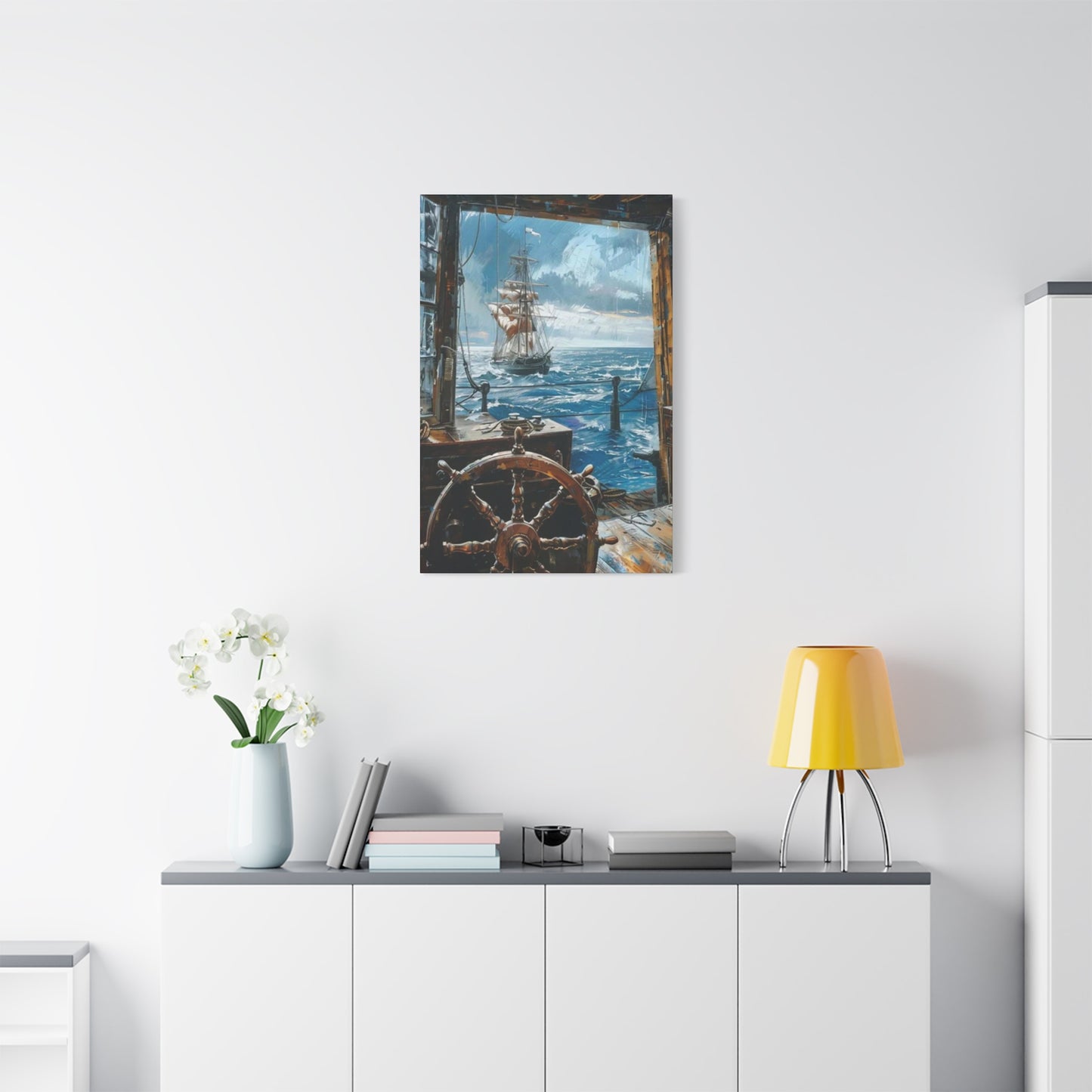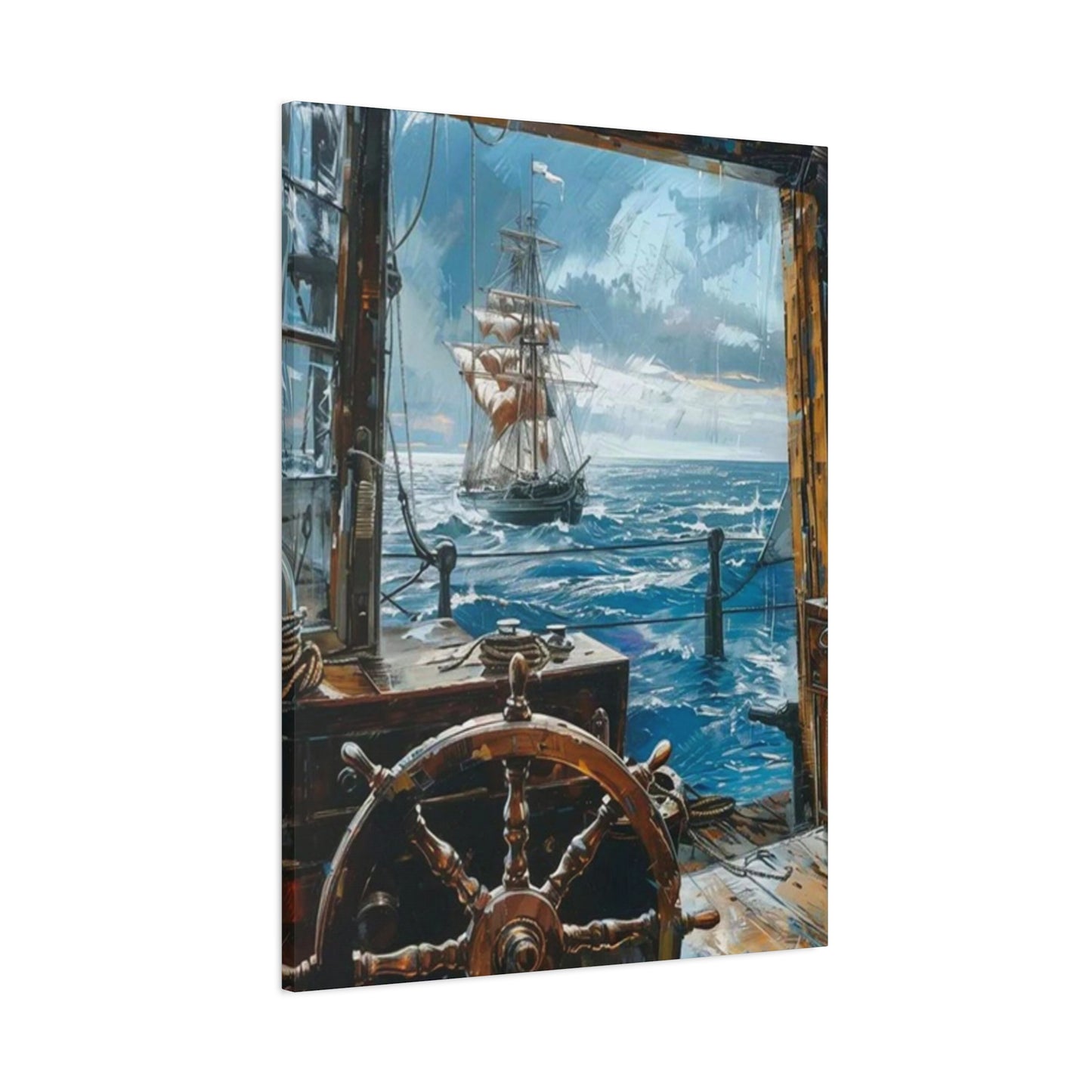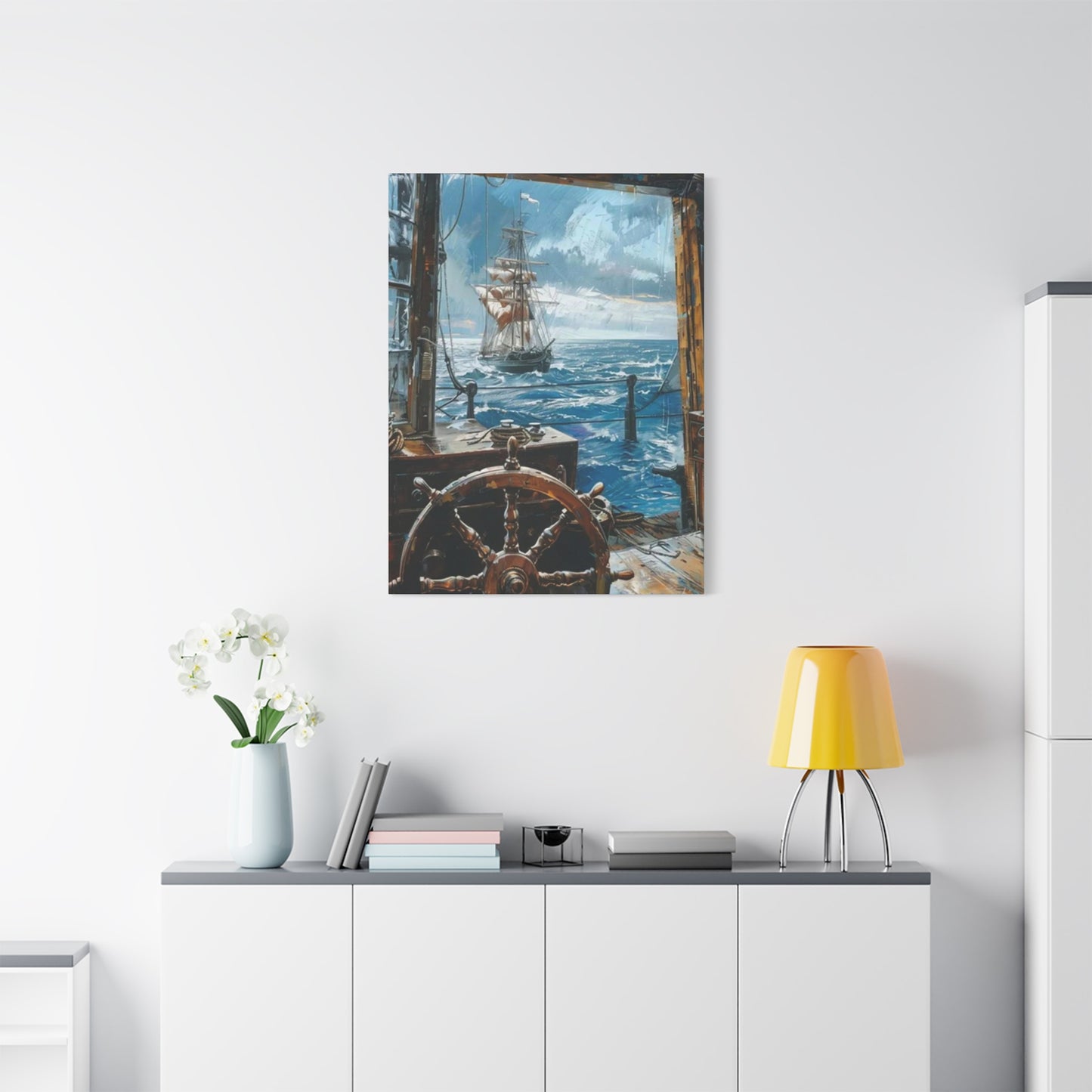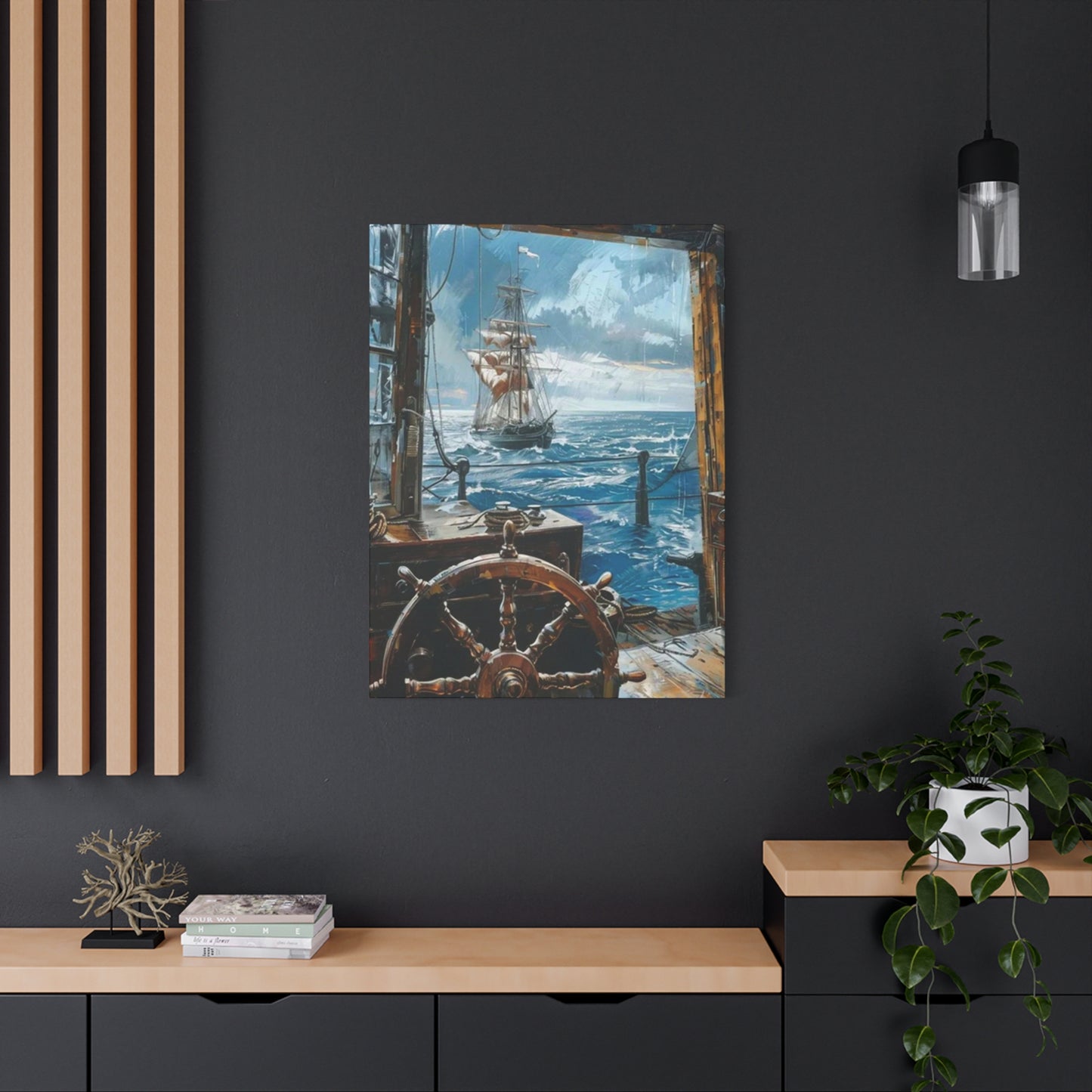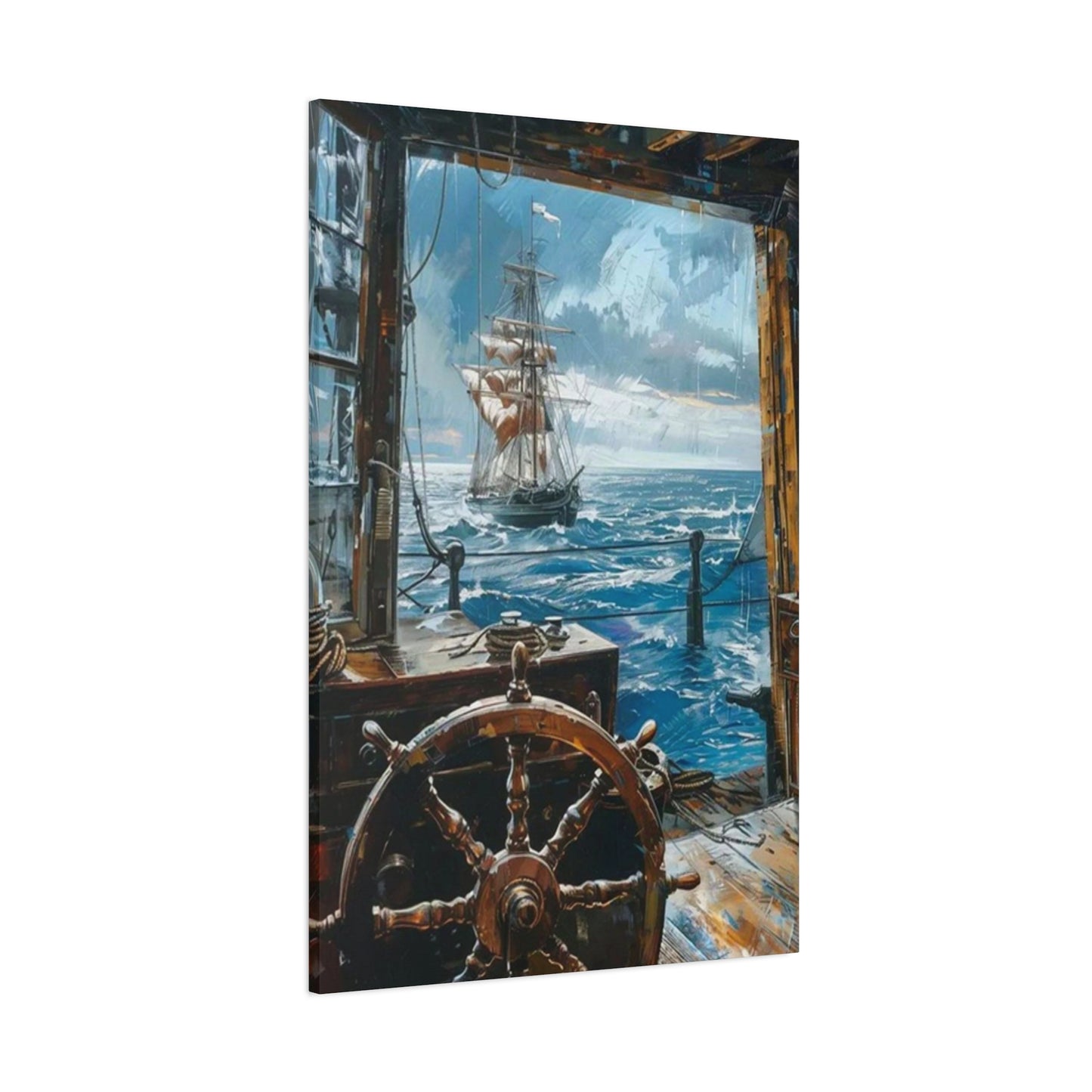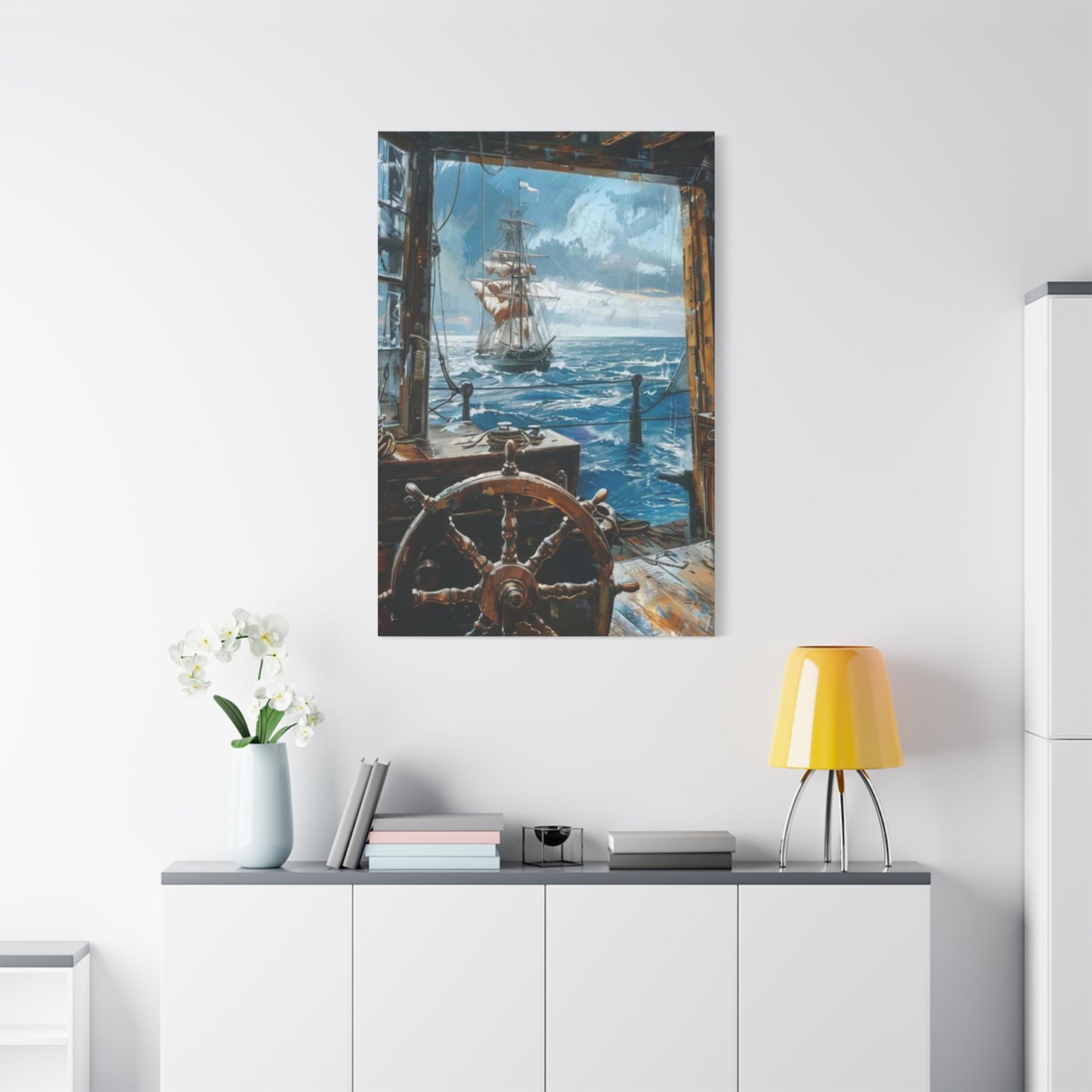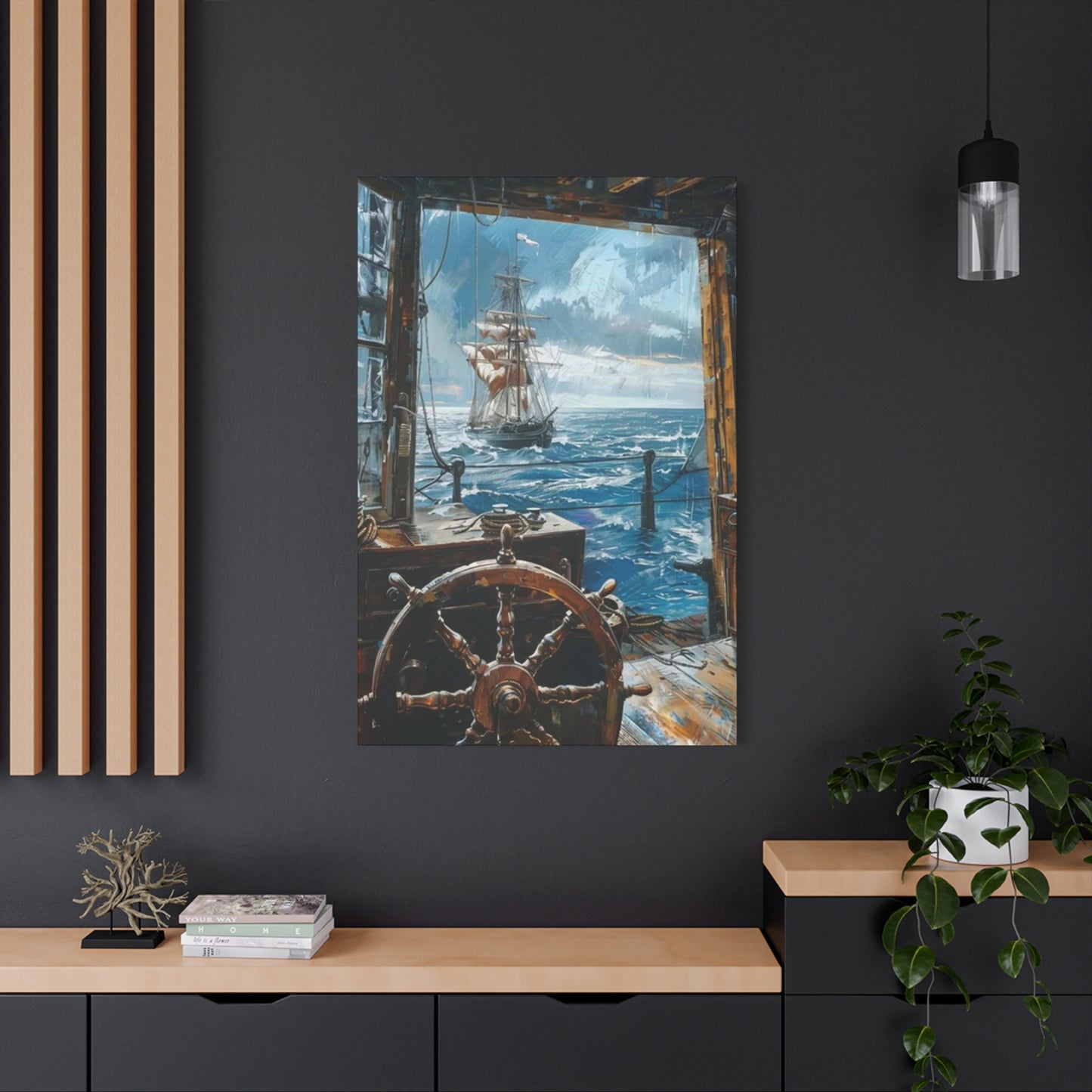Choosing the Perfect Ship Sailing POV Wall Art for Coastal or Modern Homes
The allure of the open sea has captivated human imagination for centuries, and today's interior design trends reflect our enduring fascination with maritime adventures. Point-of-view sailing artwork offers a revolutionary approach to bringing oceanic experiences into residential and commercial spaces, creating immersive environments that transport viewers directly onto the deck of a vessel cutting through azure waters. This comprehensive exploration delves into the transformative power of perspective-based nautical art, examining how these dynamic pieces can reshape interior atmospheres while celebrating the timeless romance of seafaring journeys.
Contemporary design enthusiasts increasingly seek artwork that offers more than mere decoration, they desire pieces that create emotional connections and experiential moments within their living spaces. Sailing perspective art fulfills this desire by placing viewers in the captain's position, gazing out across endless horizons where sky meets sea. These artworks capture the exhilarating sensation of standing at a ship's bow, feeling the salt spray on your skin and watching waves part beneath the hull. The psychological impact of such immersive imagery extends beyond aesthetic appeal, offering daily reminders of freedom, exploration, and the boundless possibilities that await beyond familiar shores.
The technical execution of point-of-view maritime art requires sophisticated understanding of perspective, composition, and atmospheric conditions that define oceanic environments. Artists working in this genre must master the interplay of light reflecting off water surfaces, the subtle gradations of color that distinguish sky from sea at distant horizons, and the authentic details that make viewers feel genuinely present aboard a sailing vessel. Whether rendered through traditional painting techniques, high-resolution photography, or digital illustration, successful perspective sailing art creates convincing spatial depth that draws viewers into the scene rather than keeping them at a distance as passive observers.
Adventure at the Helm
Standing at the helm of a sailing vessel represents one of life's most exhilarating experiences, combining responsibility, skill, and the raw thrill of harnessing natural forces to propel through water. Artwork capturing this specific vantage point brings that commanding perspective into interior spaces, allowing homeowners and office workers to channel the confidence and decisiveness required of maritime navigation. The helm position offers a unique visual composition, typically featuring the ship's wheel in the foreground, navigational instruments arrayed within reach, and the vast expanse of ocean stretching toward the horizon beyond the bow.
The psychological impact of helm perspective artwork extends beyond simple decoration. These pieces subtly communicate leadership qualities, suggesting the viewer possesses the capability to chart their own course through life's unpredictable waters. In professional environments, such imagery reinforces themes of strategic thinking, adaptability, and the courage required to venture into uncharted territories. The helm represents decision-making authority, and displaying artwork from this perspective can serve as a daily reminder of personal agency and the power to determine one's own direction.
From a compositional standpoint, helm perspective art offers rich opportunities for visual interest through the inclusion of authentic maritime details. The ship's wheel itself, whether traditional wooden spokes or modern stainless steel, provides a strong geometric anchor for the composition. Surrounding elements might include compass roses, depth finders, wind speed indicators, and chart tables, each adding layers of authenticity and narrative complexity. The contrast between these mechanical, human-made elements in the foreground and the organic, ever-changing seascape beyond creates dynamic tension that keeps the eye engaged.
Color palettes in helm perspective artwork typically balance the warm tones of wooden decking and brass fixtures against the cool blues and greens of ocean waters. This temperature contrast creates visual harmony while maintaining energy and movement within the composition. Artists may emphasize the golden glow of late afternoon sun illuminating the helm station, or the dramatic contrast of stormy skies against whitecaps breaking across the bow. Weather conditions dramatically affect the mood conveyed by helm perspective pieces, with calm seas suggesting peaceful mastery and rough waters implying challenge and adventure.
The inclusion of helm perspective art in residential spaces works particularly well in studies, home offices, and personal libraries, where the imagery supports contemplative decision-making and strategic planning. In commercial settings, these pieces enhance conference rooms, executive offices, and hospitality spaces where leadership and vision are valued qualities. The perspective naturally encourages forward-thinking attitudes, as the viewer's eye is drawn along the same trajectory the ship travels, always looking ahead rather than dwelling on what lies behind.
Technical execution of convincing helm perspective requires careful attention to scale and proportion. The ship's wheel must appear at a believable size relative to the human viewer's expected position, while background elements must diminish appropriately with distance. Atmospheric perspective, where distant objects appear hazier and less saturated than foreground elements, becomes crucial for creating convincing depth. Artists must also consider the subtle movement implied by the scene, perhaps suggesting gentle rolling motion or the spray of water against the hull as the vessel cuts through waves.
The historical significance of helm positions adds cultural depth to these artworks. Throughout maritime history, the helm has represented command authority, with the helmsman responsible for the safety of crew and cargo. This legacy imbues helm perspective art with symbolic weight that resonates even with viewers who have never personally sailed. The imagery connects to archetypal narratives of exploration, discovery, and the human drive to venture beyond known boundaries into mysterious realms.
Modern interpretations of helm perspective art may incorporate contemporary sailing vessels, from sleek racing yachts to luxurious cruising sailboats, each offering distinct aesthetic qualities. Racing yacht perspectives emphasize speed and performance, with minimalist compositions focusing on cutting-edge design and hydrodynamic efficiency. Cruising vessel perspectives might highlight comfort and leisure, showing more expansive deck spaces and luxurious appointments. Traditional tall ship perspectives connect viewers to maritime heritage, featuring period-appropriate details that evoke the age of exploration.
The versatility of helm perspective imagery allows it to complement various interior design styles. In modern minimalist spaces, clean photographic prints with simple compositions work beautifully, while traditional interiors may call for oil paintings with rich textures and classical color palettes. Coastal and nautical themed rooms obviously embrace this imagery naturally, but helm perspective art also adds unexpected interest to urban lofts and contemporary apartments, bringing organic movement and natural elements into otherwise hard-edged environments.
When selecting helm perspective artwork for specific spaces, consideration of scale proves essential. Large-scale pieces create dramatic focal points that dominate walls and define room character, while smaller works can be grouped in collections that tell broader stories about maritime adventures. The size selection should relate to viewing distance, with larger pieces appropriate for spaces where viewers will stand several feet away, and more intimate scales suited to closer examination where details reward careful observation.
Ocean Views, Sailor's Eyes
Experiencing the ocean through a sailor's eyes differs fundamentally from observing it as a land-based spectator. Sailors develop intimate knowledge of water conditions, reading subtle signs in wave patterns, cloud formations, and color shifts that escape casual notice. Artwork capturing this seasoned perspective brings expert observation and deep appreciation for oceanic environments into interior spaces, offering viewers access to knowledge accumulated through countless hours spent at sea. These pieces communicate not just visual beauty but the practical wisdom that comes from understanding the sea as both majestic force and navigable medium.
The sailor's gaze encompasses both admiration and respect, recognizing the ocean's power while possessing the skills to work in harmony with its moods. Artwork reflecting this balanced perspective avoids romanticizing the sea into something purely decorative, instead presenting it with honest complexity. Calm passages appear peaceful yet vigilant, while stormy scenes convey challenge without descending into melodrama. This authentic representation resonates particularly with viewers who have personal maritime experience, while also educating those less familiar with the realities of life at sea.
Color observation in sailor's perspective art demonstrates sophisticated understanding of how water reflects and refracts light under varying conditions. Shallow coastal waters appear distinctly different from deep ocean passages, with turquoise and aquamarine hues giving way to deeper navy and indigo tones. The sailor's eye notices how sunlight creates glittering pathways across wave surfaces, how overcast conditions flatten colors into more uniform grays and steels, and how sunrise and sunset transform entire seascapes into temporary masterpieces of pink, orange, and gold.
Wave pattern representation separates authentic sailor's perspective art from generic seascapes. Experienced sailors recognize different wave types, from the long, rolling swells of open ocean to the shorter, choppier waves created by local wind conditions. They understand how waves interact with currents, how they build and break, and how their character changes with weather systems. Artwork incorporating this knowledge demonstrates technical authenticity that adds credibility and depth to the piece, even for viewers who may not consciously recognize these specific details.
The positioning of the horizon line in sailor's perspective art carries both technical and psychological significance. Traditional maritime practice teaches that the horizon appears at eye level regardless of the viewer's height above water, a principle that artists must honor to create convincing perspective. The horizon's placement also affects mood, with lower positions creating expansive sky and suggesting openness or vulnerability, while higher horizons emphasize the water itself and create more enclosed, intimate compositions.
Weather conditions provide essential narrative context in sailor's perspective artwork. Clear skies with gentle breezes suggest ideal sailing conditions and create uplifting, optimistic moods. Approaching storm systems introduce drama and tension, with darkening clouds and increasing wind visible in wave patterns and sail positioning. Post-storm scenes, with clearing skies and calming seas, convey relief and renewal. Each weather scenario communicates different emotional tones while remaining grounded in authentic meteorological observation.
The inclusion or exclusion of other vessels in sailor's perspective compositions significantly impacts their meaning. Solitary passages emphasize themes of independence, self-reliance, and peaceful solitude, appealing to viewers who value introspection and personal space. Compositions showing other sailboats suggest community, shared passion for sailing, and the social dimensions of maritime culture. The appearance of dolphins, seabirds, or marine mammals adds life and connection to the broader oceanic ecosystem.
Lighting conditions dramatically affect the character of sailor's perspective artwork. Morning light, with its crisp clarity and long shadows, suggests new beginnings and fresh starts. Midday sun creates strong contrasts and intense colors but can also appear harsh and challenging. Late afternoon golden hour bathes scenes in warm, flattering light that enhances colors and softens contrasts, creating nostalgic, romantic moods. Twilight and night passages introduce mystery and quiet contemplation, with navigation lights and stars providing orientation in darkness.
The technical execution of realistic water surfaces challenges even experienced artists, requiring careful observation of how light interacts with moving water. Successful renderings capture the translucency of thinner wave crests, the opacity of deeper troughs, the foam patterns created by breaking waves, and the subtle color variations throughout. Digital photography offers certain advantages in capturing these ephemeral details, while traditional painting techniques allow for interpretive emphasis that can enhance emotional impact beyond pure documentation.
Sailor's perspective art serves educational functions beyond decoration, helping viewers understand maritime environments and sailing practices. Compositions showing sail trim, rigging details, and navigation techniques subtly communicate how sailors harness wind power and navigate safely. This educational dimension adds lasting value to the artwork, transforming it from simple decoration into a window onto specialized knowledge and skills that most viewers will never personally develop.
Sailing POV Wall Magic
The transformative power of point-of-view sailing artwork lies in its ability to transport viewers instantly from their current location into entirely different environments and mindsets. This psychological transportation creates what interior designers call experiential decor, where artwork functions not merely as visual enhancement but as a portal to alternative experiences and emotional states. The magic occurs when viewers momentarily forget they are looking at a two-dimensional representation and instead feel genuinely present aboard a vessel, with all the sensory and emotional associations that experience entails.
Achieving this immersive effect requires careful attention to perspective accuracy and compositional choices that reinforce the viewer's position within the scene rather than outside it. First-person perspective places the implied camera or painter's eye at the same position a person would naturally occupy, whether standing at the bow, seated in the cockpit, or gripping the helm. This eye-level positioning creates immediate identification, allowing viewers to project themselves into the scene naturally and without conscious effort.
The psychological mechanism behind this transportation effect connects to human capacity for empathetic imagination. When presented with convincing first-person perspective, our brains automatically construct narratives about being in that position, feeling the deck beneath our feet, sensing wind direction and temperature, and anticipating the next wave. These micro-stories unfold in milliseconds but create powerful emotional responses that accumulate with repeated viewing, building deeper connections to the artwork over time.
Color psychology plays significant roles in how sailing perspective art affects viewer mood and energy levels. Blues and greens, dominant in oceanic imagery, generally promote calmness, mental clarity, and reduced stress responses. These colors lower blood pressure and heart rate, creating physically measurable relaxation effects. The specific shades matter considerably, with darker navy blues suggesting depth and mystery while lighter aquas feel more energizing and optimistic. White elements, from sails to foam, introduce freshness and cleanliness associations.
Dynamic composition techniques prevent sailing perspective art from becoming static or boring despite their often-similar subject matter. Diagonal lines created by bowsprits, railings, or sail edges introduce movement and visual energy. The placement of the horizon line off-center rather than bisecting the composition centrally creates more interesting spatial divisions. Including foreground elements like rope coils, deck fittings, or partial views of sails provides depth cues that strengthen the three-dimensional illusion.
The scale of sailing perspective artwork significantly impacts its transformative effect on interior spaces. Large-scale pieces, measuring four feet or more in either dimension, create commanding presences that can define entire room characters. These substantial works function almost as architectural elements, similar to windows opening onto oceanic vistas. Medium-sized pieces integrate more subtly while still providing strong focal points, while smaller works might be grouped in themed collections that allow for more complex storytelling through multiple perspectives and conditions.
Installation positioning affects how effectively sailing perspective art creates its magical transportation effect. Pieces positioned at natural eye level when standing or sitting invite direct engagement and facilitate the identification process. Lighting becomes crucial, with options ranging from natural window light that changes throughout the day, to dedicated picture lights that ensure consistent visibility, to ambient room lighting that integrates the artwork into overall illumination schemes. Avoiding glare on glass surfaces or glossy prints ensures the image remains clearly visible from various viewing angles.
The framing and presentation of sailing perspective art should enhance rather than distract from the immersive experience. Simple, clean frames in natural wood, black, white, or metallic finishes keep attention focused on the image itself. Wide mats create breathing room around the artwork, preventing visual crowding. Canvas gallery wraps, where the image continues around the stretcher bar edges, eliminate framing entirely and create more contemporary presentations. Acrylic face mounting offers modern, glossy finishes with enhanced color saturation and depth.
Thematic consistency in sailing perspective art collections creates more powerful cumulative effects than random assemblages of marine imagery. A series showing the same vessel at different times of day tells a temporal story about changing light and conditions. Multiple perspectives from different positions on the same boat provide comprehensive understanding of that vessel's character. Seasonal variations demonstrate how the same waters transform throughout the year. These curated collections reward repeated viewing and sustained attention.
The versatility of sailing perspective art allows it to complement surprisingly diverse interior design styles. Obviously perfect for coastal and nautical themes, this imagery also enhances modern minimalist spaces by introducing organic elements and movement. Traditional interiors benefit from the classical subject matter and timeless appeal. Industrial lofts gain softness and natural connection. Even highly ornate, maximalist spaces can incorporate sailing perspectives as breathing room amid visual complexity, providing restful focal points where the eye can relax.
Waves from the Deck
Observing waves from a vessel's deck provides entirely different perspectives than watching them from shore. The deck viewer experiences waves not as distant phenomena but as immediate, tactile realities that lift and lower the platform beneath their feet. This intimate relationship with wave action creates artwork that conveys motion, power, and the dynamic interaction between human engineering and natural forces. Deck perspective wave art captures specific moments when water and vessel meet, whether gentle rolling motions or dramatic spray breaking over the bow.
Wave formations reveal ocean conditions and weather patterns to experienced observers. Long-period swells rolling under a vessel indicate distant storm systems, their energy traveling thousands of miles before reaching the current location. Short, choppy waves suggest local wind conditions, with wave height and frequency increasing as wind speed intensifies. Confused sea states, where waves from multiple directions intersect, create challenging navigation conditions that skilled sailors must read and anticipate. Artwork capturing these various wave patterns communicates different moods and sailing conditions.
The angle from which waves approach a vessel dramatically affects both the sailing experience and the visual composition. Head seas, waves meeting the bow directly, create dramatic spray and require powerful upward thrust as the vessel climbs each wave face. Beam seas, arriving perpendicular to the hull, cause rolling motions that challenge balance and comfort. Following seas, overtaking from astern, can provide exhilarating surfing sensations as waves lift and accelerate the vessel. Quarter seas, approaching at oblique angles, create complex motions combining multiple directional forces. Each approach angle offers distinct compositional opportunities.
Color variations in wave surfaces provide rich material for artistic interpretation. Wave crests, where water is thinnest and most agitated, appear lighter and more translucent, sometimes nearly white with foam. Wave troughs, containing greater water depth, show darker, more saturated blues or greens. The contrast between these light and dark areas creates the visual rhythm that makes wave artwork dynamic rather than flat. Reflected sky colors further modify water tones, with golden sunlight, pink sunsets, or gray storm clouds all influencing the overall palette.
Foam patterns created by wave breaking provide both visual interest and authentic detail in deck perspective art. The V-shaped wake spreading from the bow demonstrates the vessel's forward motion through water. Foam trails along the hull show water flow patterns and sailing speed. Spray blown back from wave crests indicates wind strength and direction. These foam elements, rendered as pure whites or off-whites, provide essential contrast against darker water colors and help define three-dimensional wave forms.
The deck itself, occupying the foreground in these compositions, provides scale reference and human context. Teak or fiberglass deck surfaces show weather effects, with wet sections appearing darker than dry areas. Deck hardware, including cleats, winches, and anchor fixtures, adds authentic detail that reinforces the maritime setting. Coiled ropes, fenders, or other equipment introduces pops of color and additional narrative elements. The condition and style of deck elements help communicate whether the vessel is a working boat, racing yacht, or cruising sailboat.
Timing proves crucial in capturing compelling wave moments. The instant before a wave breaks offers maximum tension and anticipation. The moment of breaking shows dramatic action and power. The immediate aftermath, with foam spreading and wave energy dissipating, suggests resolution and calm. Photographers and artists seeking to capture these moments must develop precise timing skills, predicting wave behavior and anticipating the split-second when composition, light, and action align perfectly.
Weather conditions transform wave character dramatically, offering diverse moods within the same basic subject matter. Calm conditions produce gentle, regular waves that feel peaceful and reassuring. Building winds create increasingly challenging waves that introduce tension and drama. Storm conditions generate genuine danger and test both vessel and crew, creating powerful imagery that respects the ocean's strength. Post-storm conditions often feature beautiful light breaking through clouds, illuminating still-agitated seas with ethereal quality.
The technical challenge of rendering convincing water motion in static artwork requires sophisticated understanding of wave physics and visual perception. Successful pieces suggest movement through carefully observed details like foam trails, spray trajectories, and the frozen instant of wave forms caught mid-development. Blur techniques in photography can convey motion, while painting allows for selective emphasis on movement elements. The goal remains creating static images that feel alive and kinetic rather than frozen and dead.
Deck perspective wave art particularly suits spaces where energy and movement are valued. Home gyms and workout areas benefit from the dynamic, active feel these pieces convey. Living rooms and family spaces gain vitality and conversation-starting visual interest. Office environments use wave imagery to suggest persistence, adaptability, and the ability to navigate changing conditions. The specific wave conditions depicted should match the desired psychological effect, from calm and reassuring to challenging and energizing.
Seas the View
The play on words in this concept emphasizes the active nature of viewing oceanic scenes, suggesting viewers should actively seize or grasp the perspective offered rather than passively consuming decoration. This approach to maritime art encourages engagement, inviting viewers to mentally position themselves within the scene and imagine the complete sensory experience beyond what vision alone can provide. The philosophy behind this concept recognizes that powerful artwork does more than please the eye; it stimulates imagination and emotional response that extends far beyond the physical boundaries of the frame.
Compositional strategies that encourage active viewing include asymmetric layouts that lead the eye on exploratory journeys across the image surface. Rather than centered, balanced compositions that can be absorbed in a single glance, these pieces reward sustained attention by revealing details and relationships gradually. A rope in the lower corner might lead upward to rigging, which directs attention toward sails, which point toward distant clouds, creating a visual circuit that keeps viewers engaged longer and encourages multiple viewings.
Depth layers in sailing perspective art invite viewers to explore spaces at varying distances from their viewing position. Foreground elements like deck fixtures or railings establish the immediate surroundings. Mid-ground areas feature the primary action, whether sail configurations, wave patterns, or other vessels. Background elements including distant shorelines, other boats, or weather systems provide context and expand the spatial field. Each layer offers details that reward careful observation, building understanding of the complete maritime environment.
The psychological invitation to participate in the scene rather than merely observe it creates stronger emotional connections between viewers and artwork. This participatory quality makes sailing perspective pieces particularly memorable and personally meaningful. Viewers begin to associate specific artworks with their own aspirations for adventure, freedom, or connection to nature. The art becomes a touchstone for these feelings, a physical anchor for abstract desires and emotions.
Seasonal variations in oceanic views provide opportunities for rotating artwork or selecting specific conditions that resonate with viewer preferences. Summer scenes feature brilliant blue skies, gentle breezes, and warm, inviting waters that suggest leisure and recreation. Autumn brings more dramatic weather patterns, with mixed conditions and transitional light quality. Winter offers stark beauty, with gray seas under low skies creating moody, contemplative atmospheres. Spring provides renewal imagery, with clearing weather and returning wildlife. Each season offers distinct moods and visual characteristics.
Geographic specificity adds another dimension to seizing maritime views. Mediterranean sailing scenes feature particular light quality, water colors, and architectural elements visible on distant shores. Caribbean waters display trademark turquoise hues over white sand bottoms. Pacific Ocean imagery might include dramatic coastal cliffs or vast, empty horizons. Atlantic crossings convey the serious adventure of extended passages. Specific geographic references help viewers connect artwork to their personal travel experiences or aspirational destinations.
The technical quality of reproduction significantly affects how effectively sailing perspective art communicates its intended experience. High-resolution printing preserves fine details that add realism and depth. Color accuracy ensures that water tones, sky gradations, and lighting effects appear as intended. Paper or canvas selection influences surface texture and how the piece interacts with ambient lighting. Inks or paints must resist fading to maintain color integrity over years of display. Professional-grade materials and processes separate investment-quality artwork from disposable decoration.
Interactive elements, where possible, enhance the seize-the-view philosophy. Augmented reality implementations might allow viewers to use smartphones or tablets to see animated versions of static prints, with moving clouds, shifting waves, or changing light conditions. Digital displays can cycle through different sailing conditions throughout the day, providing constantly changing views. Physical elements like actual ship bells, brass fixtures, or rope elements mounted alongside prints create multi-sensory experiences that extend beyond pure visuals.
The curation process for selecting sailing perspective art should consider the specific emotions and experiences viewers hope to access. Adventurous spirits might gravitate toward dramatic weather conditions and challenging sailing scenarios. Those seeking stress relief might prefer calm passages under clear skies. Travelers and explorers might choose images featuring distant horizons and unknown destinations. Understanding the psychological purpose the artwork will serve helps narrow choices and ensures satisfaction with final selections.
Educational components can enhance the seize-the-view experience by helping viewers understand what they are seeing. Subtle labeling of sailing terminology, nautical equipment, or sailing techniques adds learning opportunities without becoming didactic or interrupting aesthetic appreciation. QR codes on frame backs or wall labels could link to additional information about the location, vessel, or sailing conditions depicted. This educational dimension adds lasting value and gives viewers more to discover with repeated engagement.
Ship Front Art Vibes
The forward-facing perspective from a vessel's bow or front deck areas offers some of the most dramatically immersive viewpoints in maritime art. This vantage point places viewers in the most forward position, literally at the cutting edge where boat meets water and known territory gives way to approaching destinations. Bow perspective creates powerful psychological associations with progress, forward motion, and pioneering spirit. The view straight ahead, unobstructed by masts or superstructure, opens onto pure possibility stretching to the horizon.
Compositional dynamics of bow perspective artwork naturally incorporate strong leading lines that draw the eye forward into depth. The hull sides converge toward the horizon according to perspective principles, creating geometric structure that guides visual exploration. Bowsprits, when present on traditional vessels, extend this leading line even further, pointing like arrows toward distant objectives. These directional cues create restless, forward-moving energy that prevents the artwork from feeling static or settled.
The bowsprit itself, when featured prominently, becomes an iconic element loaded with maritime symbolism. These extensions beyond the bow serve functional purposes, providing attachment points for forward sails and modifying sailing characteristics. Artistically, they introduce human engineering into natural seascapes, showing how sailors have developed specialized tools for working with wind and water. The bowsprit dividing sky and sea creates strong compositional structure while maintaining the forward-focused perspective.
Spray and water interaction with the bow provides spectacular visual interest in ship front art. The distinctive bow wave pattern, where water parts and flows along hull sides, demonstrates physics in action as the vessel displaces water proportional to its size and speed. In heavy conditions, green water and white spray can completely obscure forward visibility temporarily, creating dramatic moments of power and temporary blindness that test sailor skill and courage. These active water elements add life and energy to compositions.
The deck area immediately behind the bow offers opportunities to include authentic maritime details that ground the perspective in reality. Anchor windlasses, mooring cleats, safety rails, and deck fittings all contribute authenticity while also providing scale references and human context. The choice of whether to keep decks clear and minimal or include working equipment affects whether the piece feels recreational or professional, leisurely or utilitarian in character.
Lighting conditions dramatically affect the mood of bow perspective art. Sailing directly into sunrise or sunset creates transcendent, almost spiritual imagery as brilliant light floods the entire forward view. Golden hour illumination transforms everything it touches into warm, glowing beauty that feels optimistic and uplifting. Backlighting from behind the viewer creates entirely different effects, with the vessel's shadow extending forward across the water and more subtle, even illumination throughout the scene.
Weather approaching from ahead creates narrative tension in bow perspective compositions. Viewers can see exactly what sailors face, whether clear skies promising easy passages or darkening clouds warning of challenging conditions to come. This meteorological anticipation adds storytelling dimension, inviting viewers to imagine how conditions might develop and what actions sailors might need to take. The forward view makes weather systems participants in the visual narrative rather than distant background elements.
The psychological impact of bow perspective differs notably from other viewpoints. Looking forward suggests intentionality, purpose, and active engagement with destiny rather than passive observation. This perspective aligns with goal-oriented mindsets and forward-planning attitudes. In professional environments, bow perspective art reinforces strategic thinking and long-term vision. In residential spaces, it encourages optimistic, future-focused attitudes and reminds inhabitants to keep moving toward their objectives.
Different vessel types create distinct bow perspective experiences. Sleek racing yacht bows emphasize speed, efficiency, and cutting-edge design. Traditional tall ship bows connect to maritime heritage and the age of exploration. Catamaran bows offer unique twin-hull perspectives with water visible between hulls. Classic wooden boat bows showcase craftsmanship and traditional boatbuilding aesthetics. Each vessel type brings different cultural associations and historical contexts to the artwork.
The technical execution of convincing bow perspective requires accurate geometric understanding of how parallel lines converge toward vanishing points at the horizon. The hull sides must diminish in width gradually and consistently to create believable depth. Water surface perspective, showing how wave patterns change with distance, adds additional complexity. Atmospheric perspective, where distant elements appear hazier and less saturated, becomes essential for creating convincing spatial depth in pieces showing long views toward distant horizons.
Sailing Dreams on Canvas
Traditional canvas as a medium for maritime art carries particular significance and associations with fine art history. Oil paintings on canvas have documented maritime subjects for centuries, creating a rich legacy that contemporary sailing art continues. The physical texture of canvas, whether smooth or prominently woven, adds tactile dimension that distinguishes it from photographic prints or digital displays. The choice of canvas as medium signals artistic intention and connects contemporary works to established traditions of marine painting.
Oil painting techniques offer unique advantages for rendering complex maritime subjects. The slow-drying nature of oils allows for subtle blending of colors, perfect for capturing gradual sky gradations from horizon to zenith. Impasto techniques, where paint is applied thickly to create surface texture, can physically model wave surfaces and foam patterns in three dimensions. Glazing techniques, applying transparent color layers over dried paint, create luminous depth particularly effective for rendering water and atmospheric conditions. These traditional approaches produce originals and limited-edition pieces with inherent value.
Acrylic painting on canvas provides faster-drying alternatives while still offering considerable versatility. Acrylics can be thinned to watercolor-like transparency or applied thickly like oils. Their quick-drying properties allow faster completion and immediate varnishing, making them practical for contemporary artists working to deadlines. Acrylics maintain color brilliance over time without yellowing, an advantage for preserving the bright blues and whites essential to sailing imagery. The medium suits both detailed realism and looser, more impressionistic interpretations.
Canvas prints of photographic or digital sailing images offer accessibility and affordability while maintaining many advantages of traditional canvas artworks. High-quality giclée printing on canvas produces archival results with excellent color fidelity and detail preservation. Gallery-wrapped canvases, stretched over wooden frames with image extending around edges, create finished pieces requiring no additional framing. Canvas texture adds visual interest and reduces glare compared to glossy photographic papers. These reproductions make sailing perspective art accessible to broader audiences.
Mixed media approaches on canvas combine various techniques and materials to create unique pieces. Artists might begin with photographically transferred base images, then add painted elements to enhance color, emphasize details, or introduce interpretive elements. Collage techniques incorporating actual maritime materials like sail fabric, rope fragments, or weathered wood create literal connections to sailing. Resin applications over painted surfaces create glossy, water-like finishes that enhance illusion and protect underlying artwork. These experimental approaches produce one-of-a-kind pieces.
The size options available with canvas support artwork ranging from intimate studies to architectural-scale installations. Small canvases work well for personal spaces, bedside tables, or office desks where viewing distances remain close. Medium sizes suit most residential applications, providing presence without overwhelming spaces. Large-scale canvases create dramatic focal points in living rooms, lobbies, or hospitality settings where their impact can be appreciated from distance. Multi-panel works spread sailing perspectives across several canvases, creating expansive installations.
Thematic series on canvas allow artists to explore sailing subjects comprehensively. A triptych might show morning, midday, and evening views from the same vessel. Multiple canvases could document a single voyage chronologically, creating narrative progression. Seasonal variations could show the same location across different times of year. These series encourage viewers to consider relationships between pieces rather than viewing each in isolation, building more complex understanding of maritime experiences and environments.
The permanence and investment quality of canvas sailing art appeals to collectors building cohesive collections. Original paintings represent unique works that can appreciate over time as artist reputations develop. Limited edition canvas prints numbered and signed by artists combine accessibility with collectibility. The substantial physical presence of canvas pieces creates more significant impact than paper prints in similar sizes. Proper care including UV-protective varnishes and appropriate display conditions ensures these pieces remain beautiful for generations.
Canvas preparation significantly affects final artwork quality. Professional-grade canvases are properly stretched and stapled to prevent warping or sagging. Priming with gesso creates ideal painting surfaces with appropriate tooth for paint adhesion. The canvas weave density, from coarse to fine, affects both painting experience and final appearance. Artists select canvas characteristics based on their specific techniques and desired effects, with detailed realism requiring finer weaves while looser, impressionistic approaches work well on coarser surfaces.
The emotional resonance of sailing dreams captured on canvas connects to universal human desires for freedom, adventure, and connection with nature. These pieces do not simply document what sailing looks like; they capture what it feels like, the emotions and sensations that make maritime experiences memorable and meaningful. Canvas as medium adds gravitas and permanence to these captured dreams, suggesting they represent significant aspirations worthy of artistic treatment and prominent display rather than casual decoration.
Ocean Journey Indoors
Bringing the experience of ocean journeys into interior spaces represents a fundamental transformation of environment and atmosphere. Indoor spaces typically emphasize security, stability, and control, the opposite of maritime environments characterized by constant motion, changing conditions, and necessary adaptation. Ocean journey art bridges these contrasting realities, introducing natural dynamism and adventure into protected indoor settings. This juxtaposition creates psychological tension that keeps spaces interesting and prevents them from feeling too static or confined.
The psychological benefits of nature connection, even through representation, are well documented in environmental psychology research. Ocean imagery specifically reduces stress responses, lowers blood pressure, and improves mood compared to urban or industrial imagery. The color blue demonstrates calming effects on nervous systems, while the horizontal orientation of horizon lines and wave patterns creates visual rest for eyes accustomed to vertical urban environments. These physiological responses make ocean journey art more than decoration, positioning it as wellness intervention that subtly improves daily life quality.
Spatial perception shifts when rooms incorporate effective ocean journey artwork. Viewers experiencing genuine transportation into maritime scenes temporarily forget physical room boundaries, their consciousness expanding to encompass the vast spaces depicted. This perceptual expansion makes rooms feel larger and less confining, particularly valuable in smaller apartments or windowless offices where space limitations might otherwise feel oppressive. The psychological breathing room provided by oceanic vistas improves comfort and reduces feelings of claustrophobia.
The narrative quality of journey-focused maritime art distinguishes it from static seascapes that simply show ocean views without implication of movement or travel. Journey pieces tell stories about departures and arrivals, about distances covered and challenges overcome. They invite viewers to imagine where vessels came from and where they are heading, what adventures preceded the captured moment and what experiences might follow. This narrative dimension engages imagination actively rather than passively, creating ongoing interest that survives repeated viewing.
Seasonal rotation of ocean journey art allows spaces to reflect changing relationships with maritime environments throughout the year. Summer installations might feature vibrant, active sailing scenes under brilliant skies that echo outdoor warmth and activity. Autumn transitions could introduce more contemplative pieces with changing light and mixed weather. Winter artwork might show dramatic storm passages or cozy harbor scenes that align with indoor-focused seasonal lifestyles. Spring installations could emphasize renewal and emergence, with clearing weather and returning wildlife.
The educational dimension of ocean journey art exposes viewers to geographic diversity and maritime culture variations worldwide. Caribbean sailing scenes introduce tropical conditions and island-hopping cruising. Mediterranean imagery showcases distinctive light quality, water colors, and cultural heritage visible in coastal architecture. Pacific Ocean passages demonstrate the scale of true ocean crossings. Polar sailing shows extreme conditions and specialized vessels required for high-latitude exploration. Each geographic focus broadens understanding of how sailing manifests differently around the globe.
Interactive storytelling opportunities emerge when ocean journey art incorporates contextual information about specific voyages or locations depicted. Wall labels or accompanying materials might explain the geographic location, sailing conditions, vessel type, or photographer/artist's experience creating the piece. QR codes could link to extended stories, additional images from the same journey, or video content showing related maritime activities. This layered information transforms simple decoration into educational resource that rewards curiosity and engagement.
The commercial applications of ocean journey art extend beyond residential decoration into hospitality, healthcare, and corporate environments. Hotels and resorts use maritime imagery to reinforce coastal locations and vacation atmospheres. Medical facilities incorporate calming ocean scenes to reduce patient anxiety in waiting areas and treatment rooms. Corporate offices use journey-focused art to communicate values like exploration, innovation, and strategic vision. Maritime industry businesses naturally embrace this imagery to reflect their core activities and cultural identities.
Conclusion
Choosing the perfect ship-sailing point-of-view (POV) wall art for a coastal or modern home is a beautiful design decision that blends visual impact with thematic appeal. The imagery of a sailing ship—whether captured from the deck looking forward, or gliding across a horizon—carries with it feelings of freedom, motion, and connection to the sea. When thoughtfully placed, this kind of artwork can transform a wall from a mere surface into a window of exploration and serenity.
One of the key advantages of ship sailing POV art is its versatility: it works equally well in a breezy beach house and in a sleek urban loft. In coastal homes, it reinforces the maritime aesthetic—helming into sunlit blues, driftwood textures, and natural fibres—while in modern homes it introduces an element of movement and narrative that bridges the gap between minimalism and interest. The horizon line of the ship scene helps to visually expand the space, making rooms feel more open and airy, which is a valuable asset in contemporary interiors.
Color and material selection play a central role. For a coastal home, look for pieces in soft aqua, sandy beige and crisp white, or vintage-washed finishes that echo seaside simplicity and natural light. In a modern home, you might choose more desaturated tones, monochrome prints, or high-gloss metal/acrylic finishes to match clean lines, industrial materials and minimalist décor. Canvas textures bring warmth and an organic feel, while smoother finishes add polish and edge.
Scale and placement are equally important. A large horizontal ship image above a sofa or buffet can become an inviting focal point. For narrower walls or transitional spaces like hallways, a vertical-oriented piece or a multi-panel configuration can maintain the theme without overwhelming the layout. Measure your available wall space and furniture dimensions: ideally the width of the artwork should be about two-thirds the furniture beneath it, or if it’s a standalone piece, leave substantial breathing room around it. Gallery-style arrangements also work if you coordinate multiple ship or sea themes in complementary sizes.
Quality matters. The crispness of the image, the richness of the print materials (archival inks, UV protection), and the finishing (framing, float mounting) all influence whether the artwork will last and look refined in your space. Because the maritime theme implies light, reflection and openness, you’ll want materials that hold up to natural light and avoid fading or wrinkling.
Finally, integrating the artwork with surrounding décor ensures cohesion and harmony. In beach-inspired homes, pair with textured rugs, sea-glass accessories, woven baskets and light wood furniture to enhance the nautical mood. In modern interiors, let the artwork stand out: minimal furniture, monochromatic colour schemes, and one or two accents (e.g., brass compass, rope detailing) are enough to tie it in without cluttering the visual field. The ship sailing POV piece becomes the hero element that anchors the room.
In summary: selecting ship sailing POV wall art is not just about finding a pretty picture—it’s about making a strategic choice that resonates with your space, your style and the message you want the room to convey. Whether you seek the relaxed openness of a coastal retreat or the crisp sophistication of a modern loft, this art theme offers a dynamic and timeless solution. Choose a composition that evokes motion and depth, match the colour and finish to your décor, scale it to your wall, and integrate it thoughtfully with surrounding elements—and you’ll have a piece of artistry that truly transforms your home into a space of elegance, narrative and visual calm.


















